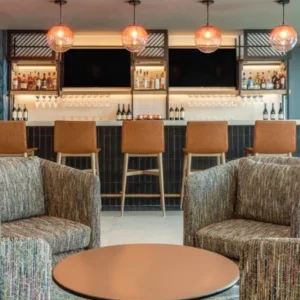Half transport hub, half shopping destination, a modern airport needs to put as much thought into its commercial aspects as it does into aviation. But despite relying on food, beverage and retail for as much as 60% of revenue, airports are not always designed to make the most of merchandise. Many terminals are not structured to encourage passengers to linger where they might be tempted by gleaming storefronts. Some, on the other hand, have taken their cue from shopping malls, which are designed to keep customers inside the complex as long as possible. Unlike mall shoppers, airline passengers tend not to see the terminal as a destination in itself: the right design and aesthetic elements can change their view of the airport from an obstacle into an extension of their journey. However, the upfront cost of refitting a terminal to be more retail-friendly often proves to be a barrier between operators and their potential profits.
Johan Berhin, designer and founder of Green Furniture Concept, aims to create that impression by achieving a “unique sense of place” with seating solutions that are sustainable, natural and seamless. His modular, curved designs follow the passenger flow lines of a building to create a pleasant environment that invites passengers to linger, relax and shop.
Berhin, who is passionate about the environment and comes from a design and engineering background, founded his first studio ten years ago, before opening Green Furniture Concept in Sweden in 2010.
“I was excited to do green furniture: to do sustainable and goodlooking, and to show the world that this was possible,” he says.
Locally inspired
Berhin has refined the art of retail-friendly seating through projects in major shopping centres, railway hubs such as Stockholm Central Station, and airports including Terminal 1 at Nice Airport and Iceland’s Keflavik International. His design for Keflavik drew on the natural volcanic beauty of Iceland, incorporating the black, grey and white of lava, stone and ice using local materials to create a unique brand closely linked to the destination.
“Travelling is an experience, and people want to bring something home from that experience. If you’re flying home from your destination and you feel that you’re still there, that will be a reason for buying something,” he says. “We like to keep having those little consistencies before we go home.”
Echoing ocean waves, winding rows of the gently curved Nova C series bench provide seating at Keflavik for 240 people and encourage them to linger in a hall lined with food, beverage and retail outlets.
“In a mall environment, if you can keep people in the mall for another minute, you raise all sales by 3%,” Berhin explains. “If you can slow down the flow for the people who have time so that they don’t rush out to the gates where they’re lost in terms of the commercial aspect, it will have a good effect on sales.” His experiences of studying traffic patterns and flow in shopping malls has taught him that they are an important design and branding inspiration for airports looking to boost their retail revenue.
“The shopping malls have their own brand and it’s very important for them to be a unique destination. Airports are very much the same, but most of them haven’t come as far in developing into commercial spaces, especially not the smaller ones. There is a lot to learn from that side.”
At Sweden’s Göteborg Landvetter Airport, the Nova benches are combined with soft lighting in the form of Green Furniture Concept’s Leaf Lamps: tree-like pendant and standing lamps covered in wool felt ‘foliage’ that absorbs sound to create a pleasant conversational environment. Green Furniture Concept previously worked with Stockholm Central Station to create seating that had the style and substance to last for decades. With input from the station’s cleaning and maintenance staff, the studio refined its existing seating solutions into a product that was durable and easy to maintain so as to survive the high-traffic environment. As time goes on, the furniture’s modular design means it can be easily reconfigured and worn-out parts replaced, reducing the need for costly refits.
Long-term commitment
When creating an airport installation, Berhin and his team incorporate the operation’s established brand with an eye towards the future. “If there’s pink in the logo of the airport, you may think twice before you make a pink bench, because in ten years the logo will probably shift,” he notes. “But you might also only have a few elements of that colour, and then you can have a changing environment by only changing a few parts.”
Local wood and stone are used whenever possible; as well as being sustainable, this helps Green Furniture Concept installations to look as if they belong in a space so that their style stands the test of time. The studio takes its commitment to sustainability further by using upcycled materials wherever possible and using hard wax oil instead of varnish, as well as planting a furniture-grade tree near its factory in Sweden for every piece of furniture it sells. Its Radius series of solid metal dividers includes seat-back or mid-seat planters, which fit around the Nova seat designs to seamlessly add greenery to the space.
Green Furniture Concept’s next project is a comprehensive seating programme incorporating seats and lighting, designed to be versatile and easily reconfigured to suit a variety of customers. “The company is going to become an architectural tool – an alternative to reconstruction,” says Berhin.
Airports wanting to grow their retail revenue need to break past the idea of the airport as a holding area and create the impression of the terminal as a destination in itself. In practice, they need a unique, destination-focused brand combined with pleasant, welcoming spaces near commercial outlets to encourage passengers to slow down and browse, without compromising on cost. When a total refit is not on the cards, modular seating constructed from natural local materials provides an answer that is sustainable for the local environment and an operator’s budget.






